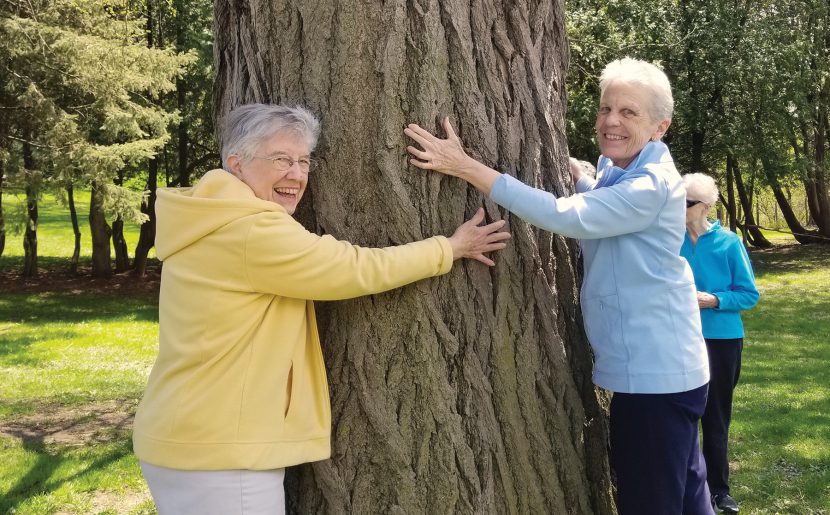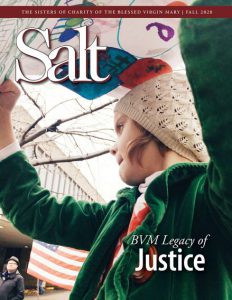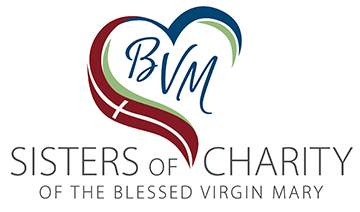A Tree Was Created to be a Tree

Be a tree hugger: BVMs Mira Mosle and Mary Ann Zollmann embrace a tree during a prayer ritual.
Featured in the fall 2020 issue of Salt magazine.
by Eileen Fuchs, BVM
I recall as a child going on trips with my family. During the journey my mother would comment on all the uncultivated land that could be used to house the homeless, which is a quite common sentiment.
Think about all the trees growing along the average highway or interstate. When you see those trees, what do you see? Lumber for building? Land that could be used for development? Potential danger in a huge storm or tornado?
Or do you see an amazing specimen of Nature that has the ability to turn the Sun’s energy into food for itself and others? Do you see a protector that absorbs carbon dioxide and breathes out oxygen? Do you just see the simple beauty in every season as a tree?
A Rose is a Rose
A tree was created to be a tree, not a house. Yes, we have used trees for houses, but it is a tree first. Flowers, as beautiful as they are, are flowers first. They were not created for our personal enjoyment.
Yes, we can enjoy, and I believe that pleases God. The flower, however, shows colors and emits scents to attract the insect that will fertilize it. We are a bystander.
Then we get to insects, or bugs if you prefer. Yes, they are part of the story. No, we do not like ants or spiders in our houses. Does that mean they do not have a right to exist? Have you ever caught an insect inside to release it outside? It just feels good. Some don’t cooperate, and unfortunately we must do something to keep them outside. Still, they do not need a purpose for human endeavors in order to exist.
Some of Nature is dangerous to us. Wouldn’t it be nice if bats stayed outside and didn’t bite? Snakes? Don’t get me started.
We certainly know the effect of viruses on all animals and plant life. So why do they exist? Is a bat’s sole purpose of existence to eat mosquitos or a snake’s to eat rats? Or does diversity in Nature supersede human needs and desires?
There are several books on the market right now that, in a way, are advocating for the rights of Nature: What a Plant Knows by Daniel Chamovitz; The Hidden Life of Trees by Peter Wohlleben and Tim Flannery; and countless books and documentaries on what an elephant knows.
We are learning to appreciate that we do not know everything about parts of Nature.
In this fifth anniversary year of Laudauto Si’, let’s make an effort to read more about Nature, not how we can use it but how it is unique and beautiful on its own.
We could also look at a tree as a tree, and all other parts of Nature as they are within themselves.
Hug a tree. Why is that such a bad thing? Thank it for oxygen and food. Tell it how beautiful it is. Honor and respect it for what it is: a tree.
 About the author: Eileen Fuchs, BVM, who died in August 2020, was a congregational representative for the Sisters of Charity, BVM and a former high school science teacher. She shared her love of Nature and all Creation with not only her students but everyone she met. According to her eulogy, “Her emails as ‘the Moon lady’ inspired many of us to turn our gaze upward and marvel at the beauty of the night sky and profoundly feel the presence of God.”
About the author: Eileen Fuchs, BVM, who died in August 2020, was a congregational representative for the Sisters of Charity, BVM and a former high school science teacher. She shared her love of Nature and all Creation with not only her students but everyone she met. According to her eulogy, “Her emails as ‘the Moon lady’ inspired many of us to turn our gaze upward and marvel at the beauty of the night sky and profoundly feel the presence of God.”
 This story was featured in:
This story was featured in:
Fall 2021: BVM Legacy of Justice In this issue of Salt, we explore justice by educating ourselves about racism, continuing BVM missions through partnerships and scholarships, and being grateful for the commitment to social justice of a 9-year-old who sees BVMs as her “religious heroes.”
If you would like to receive Salt, contact the Office of Development for a complimentary subscription at development@bvmsisters.org or 563-585-2864. Click below to read the current issue.
